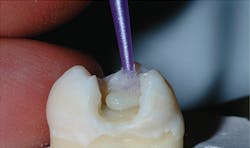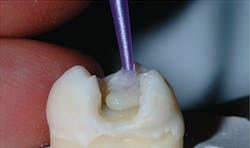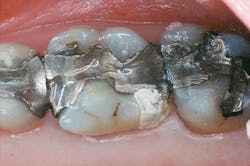The biomimetic approach
Saul Pressner, DMD, FAGD
Biomimetic dentistry seeks to promote the science and merits of tooth-conserving dentistry. When compared to more traditional methods, these concepts can result in greater longevity of the natural dentition.
Teeth restored with biomimetic methods are less likely to need crowns, endodontic therapy, and potential extraction. Biomimetic methods, and the concepts behind them, help the dentist to learn proper caries detection and removal, as well as more conservative restoration of tooth structure that reflects the design of the natural tooth.
From an economic standpoint, biomimetic methods are of tremendous benefit to the patient. Treatments are often less expensive in the long term, and restorations are often reparable. Patients are more likely to be satisfied with the idea of "less is more," preserving what nature has provided. Satisfied patients, of course, are a good thing, as studies have shown that happy patients are more likely to refer more like-minded patients to your practice.
Biomimetic treatments are often easier for patients to tolerate, creating a more pleasant experience for patient and doctor alike. Moreover, the dentist has the opportunity to deliver more efficient and effective care at a fair fee structure. By being more efficient and providing potentially longer-lasting and healthier restorations, there is a tremendous economic benefit for the dentist because it serves as an internal marketing tool (i.e., many more satisfied patients and new referrals.)
In these lean economic times, patients are seeking lower-cost alternatives to traditional crown and bridge, endodontics, and post and cores. With biomimetic tooth-conserving techniques, we are often able to perform procedures that are less likely to result in catastrophic tooth loss for the patient, conserving economic resources for the patient in the long term. The biomimetic approach is truly in the realm of the Hippocratic Oath, "Do no harm."
Biomimetic dentistry seeks to promote the following concepts:
1. | Conservation of more dental pulps |
2. | Repairs or elimination of cracks |
3. | Removal of pathology |
4. | Saving maximum amounts of tooth structure |
5. | Strengthening of tooth structure |
6. | Delaying the re-treatment cycle |
According to Dr. Harold Heymann, professor of restorative dentistry at the University of North Carolina, C-factor is defined as "the percentage of bonded to unbonded surfaces in a tooth preparation." In biomimetic dentistry, we seek to reduce C-factor in order to increase the longevity of our restorations. We do this through specific diagnostic and treatment protocols and the use of certain materials. The goal is to eliminate bacterial contamination in the cavity preparation, increasing bond strengths and limiting stresses within the composite.
According to Drs. Alleman and Deliperi, founders of the Alleman-Deliperi Center for Biomimetic Dentistry, certain protocols help reduce C-factor in restorations. These protocols, which can enhance the longevity of restorations, include:
1. Incremental placement of composite
2. Delayed curing protocols
3. Elevation of proximal margins
4. Use of Ribbond fiber to decrease stresses within the composite and reinforce compromised tooth structure
Layering, according to Dr. Alleman and others, allows for fewer stresses to develop within the composite. Less polymerization shrinkage may occur using this method as opposed to bulk fill. In the January 2012 Clinicians Report, bulk fill still presents issues of voids in crucial locations within the composite as well as the issue of light curing not reaching the bottom of deep preparations. This depth-of-cure issue for bulk cure vs. incremental fill was also addressed in the Journal of the American Dental Association October 2013 by Tiba et al. In Operative Dentistry March/April 2015, Benetti et al., found that in Class II cavities, some bulk-fill composite resins result in larger gaps on dentin walls than observed for conventional resin composites. Therefore, many biomimetic dentists consider layering techniques to be a more effective restorative technique than bulk fill.
Delayed curing protocols and elevation of proximal boxes also result in less marginal breakdown and longer-lasting biomimetic restorations with a reduction of the C-factor.
Ribbond fiber helps reduce stresses within the composite and has been shown to increase longevity of such restorations. In certain cases, Ribbond can also be used to bridge cracks within dentin (Figure 1). We place the Ribbond fiber using a bonding applicator wet with unfilled resin. We can apply a flowable composite to the tooth surface and then press the Ribbond in close approximation to the underlying substrate. According to Dr. Simone Deliperi (February 2015 Dental XP lecture on biomimetic dentistry), this allows for a greater reinforcement effect on the underlying substrate, be that dentin or composite.
Figure 1
Figure 2-Structural compromise, cracks and gaps lead to infection
Figure 3
As dentists, we all know that proper treatment begins with a thorough diagnosis. In Figure 2, we see an upper first molar with a fractured and leaking amalgam, along with a temporary filling replacing a fractured disto-palatal cusp. We can clearly see cracks and gaps present, which lead to bacterial contamination and infection of tooth structure. Such a tooth can be restored successfully using biomimetic tooth-conserving methods and materials rather than resorting to more aggressive "tooth amputation'' techniques. In this case, an onlay restoration was fabricated to replace missing tooth structure and reinforce the remaining tooth substrate (Figure 3).
In biomimetic dentistry, we seek to prevent unnecessary removal of tooth structure as reported in the peer-reviewed literature. According to Larson, Douglas, and Geistfeld (1980, University of Minnesota), "The reduction of occlusal enamel is the first step toward the weakening of the crown of the tooth."
Biomimetic dentistry provides an excellent economic benefit for both the dentist and the patient. It is a win-win situation for both parties. Upon mastering these techniques, the dentist can deliver a higher level of care at a lower cost to the patient. The dentist can operate more efficiently once these methods have been mastered so as to complete more high-quality restorations of a longer-lasting nature. This is done in a more comfortable manner for the patient. Patients receiving this type of care are more likely to refer their friends and families when they realize that the dentist is striving to maintain their natural dentition with longer-lasting restorations. If failure of the restoration occurs, it is less likely to be catastrophic in nature, resulting in tooth loss. This is good internal marketing, as patients prefer to retain their natural teeth in a healthy condition for as long as possible.
As dentists, we all endeavor to provide the best possible care to our patients. By mastering proper diagnostic and treatment protocols to preserve tooth structure, we are giving patients the best chance to maintain their dentitions in optimal health, thus enhancing their overall quality of life and well-being.
Visit the Academy of Biomimetic Dentistry website at www.academyofbiomimeticdent.org to learn more about biomimetic dentistry. Consider attending our annual meeting to be held in Philadelphia, Pennsylvania, from October 15-18, 2015, at the Philadelphia Airport Marriott. Our list of speakers includes: Drs. Milicich, Inokoshi, Blatz, Sema-Belli, Cox, Alleman, Deliperi, Bertolotti, and others. We are proud to be affiliated with Penn Dental Medicine, Quintessence Publishing, and other distinguished sponsors for this event. Please join us for a life- and career-changing symposium.
Saul Pressner, DMD, FAGD, received his dental degree from Penn Dental Medicine. He completed a residency in family dentistry at the University of Connecticut School of Dental Medicine. He is the president-elect of the Academy of Biomimetic Dentistry as well as a member of the Dean's Council at Penn Dental Medicine. He serves on the board of the American Friends of DVI. Dr. Pressner maintains a private dental practice in Manhattan.



